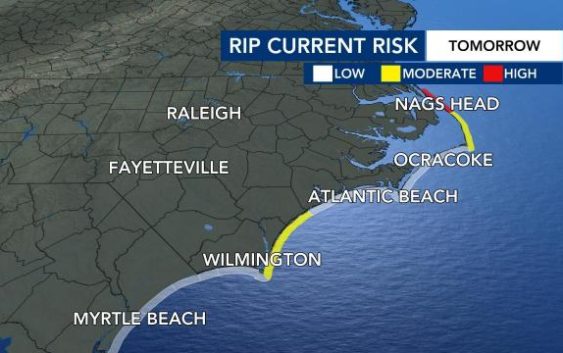- Seven months after Hurricane Helene, Chimney Rock rebuilds with resilience
- Wildfire in New Jersey Pine Barrens expected to grow before it’s contained, officials say
- Storm damage forces recovery efforts in Lancaster, Chester counties
- Evacuation orders lifted as fast-moving New Jersey wildfire burns
- Heartbreak for NC resident as wildfire reduces lifetime home to ashes
Rip currents from Hurricane Larry expected to worsen over next few days

Wrightsville Beach, N.C. — While Hurricane Larry isn’t expected to affect North Carolina directly, the system is causing a dangerous rip current risk along our coast.
Steering currents will help keep Larry away from the U.S., but North Carolina’s coast experienced some rip currents or large ocean swells over Labor Day weekend, and several more days of dangerous conditions are expected.
Fourteen rip current-related rescues were made Saturday at Wrightsville Beach. Another 16 rescues were made at New Hanover County beaches on Sunday, and six more were reported Monday. No fatalities were reported.
On Tuesday morning, Larry was still a major Cat. 3 hurricane.
“The rip current risk now up to the high category across some of our beaches,” WRAL meteorologist Peta Sheerwood said. “The rip current risk is expected to increase today and tomorrow.”
According to Sheerwood, drier air will prevent Larry from developing further. Instead, the storm is likely to weaken as it moves northward this week.
Although only one moderate rip current was measured on Monday, Sam Proffitt, of Wrightsville Beach Ocean Rescue, said conditions will worsen as the system gets closer to the U.S.
“The [National] Weather Service is saying, starting at some point Wednesday – Wednesday afternoon – we’re going to start seeing the swell coming in from the hurricane,” Proffitt said. “They’re predicting anywhere from about 4- to 8-foot swells [at] about 15- to 20-second intervals. So, it’s going to be a longer interval swell coming in.”
Lifeguard stands will almost certainly be flying red flags, urging people not to get into the water, later in the week and the upcoming weekend, he said. Still, he anticipates even more water rescues as people ignore the rip current threat.
“It’s just going to be dangerous up and down the entire East Coast, particularly up and down the North Carolina coast, and so, if you do go out to the beach – I know a lot of people are still vacationing – it’s just not worth the risk this week,” he said. “We know that we’re going to have rip currents, and it’s just not worth the risk.”
Fewer lifeguards will be on North Carolina beaches starting Tuesday, as the fall season begins. Officials said it’s not enough to be within sight of a lifeguard stand; people also need to make sure the stand has a lifeguard on duty.